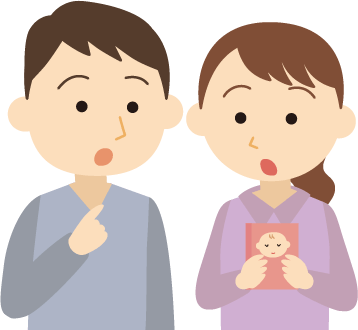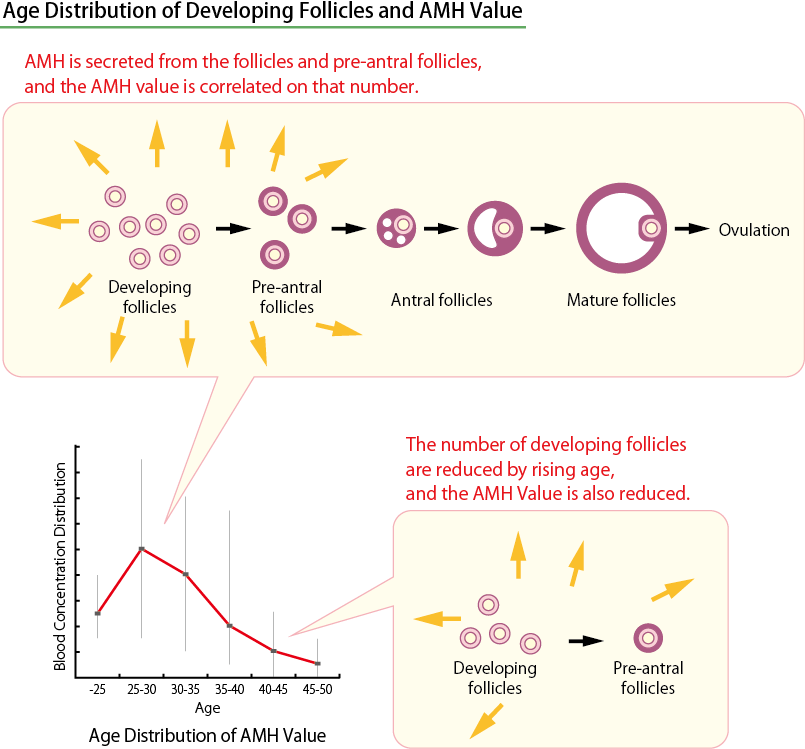
Anti-Mullerian Hormone Check is sometimes referred to as "measuring ovarian age," but more precisely, it estimates the number of eggs remaining in the ovaries and predicts how many chances of pregnancy and childbirth are left in the future.
It is determined by blood tests such as anti-mullerian tubular hormone (AMH), also known as ovarian age test, and ultrasound examinations.

Ovarian reserve testing includes blood tests and ultrasound.
Ultrasound examinations measure the number of AFC (follicular follicles) in the uterus.
Blood tests measure AMH levels and perform ovarian reserve tests.
AMH (Anti-Mullerian Hormone) is a hormone secreted from follicles in the process of development. By measuring the AMH concentration, it is possible to measure the number of remaining follicles and estimate the ovarian age.
A woman's ovary contains a large number of primordial follicles from birth, and from the time of menarche, the primordial follicles become active and mature, and it takes about 190 days to ovulate.
AMH is secreted from preantral follicles and its measurement correlates with the number of developing follicles.
Therefore, by measuring the AMH concentration, it is possible to measure the number of remaining follicles and estimate the age of the ovaries.
The Follicle Stimulating Hormone (FSH) to promote follicular maturation is also a hormone which is an indicator of the ovarian reserve function.
Although it is shown to lower and increase the ovarian function, because it varies greatly depending on the menstrual cycle, it is hard to accurately predict the ovarian age from the value of FSH.
Therefore the measurement of AMH is thought as to be the most quickest and accurate test that can detect the decrease in the ovarian reserve function.
As for the number of developing follicles in the peak ages of women 25 to 30 years old, they will decline as one ages, and at the same time there will be a decline in the concentration of AMH in the blood stream.
When there is a low concentration of AMH, not only is it difficult for there to be a natural ovulation, it will be quite often a thing that the ovary doesn’t respond to stimulated ovulation in infertility treatment, and even though the timing method and artificial insemination and In Vitro Fertilization are carried out, it has become a situation of concern that because the follicle will not develop, there is no choice but to abandon the treatment.
Understanding the ovarian age in order to avoid such a situation is important.
In addition, because you can choose the appropriate method of ovulation stimulation by knowing the number of developing follicles in the ovary, on the other hand you can reduce the risk of Ovarian Hyper-Stimulation Syndrome (OHSS) resulting in the ovary swelling up due to too many growing follicles and proceed with treatment efficiently.
Aging from follicle growth
An undeveloped follicle stored in the ovary.
It contains the source of the egg.


Pre-antral follicles
A follicle with a thicker layer and a follicular cavity that has begun to form.


Antral follicles
As the follicle grows, more hormones are secreted and it grows.


Mature follicle
Follicle just before ovulation.
Also called Graaf's follicle.


Normally, at the beginning of the menstrual cycle there will be a number of follicles developing within the ovary, but the closer the time comes to ovulation, only one will become bigger.
This one is called the dominant follicle.
The dominant follicle will get hormone stimulation and mature, then ovulate.
Polycystic Ovary Syndrome (PCOS)is the condition where as ovulation period draws nearer the dominant follicle doesn’t develop and within the ovary there are many small follicles.
It will become difficult to ovulate and in some cases a chance of infertility, amenorrhea, and rare menstrual cycles.
The AMH Value will be high in Polycystic Ovary Syndrome.
The state of the ovaries is greatly influenced by the success of the infertility treatment.
When AMH is high, because it will be easy to be afflicted with the Ovarian Hyper-stimulation Syndrome (OHSS: Condition of a swollen ovary due to an excess in ovary stimulation that leads to a number of developing follicles), there is a need to reduce the stimulation by adjusting the method of ovulation induction.
In the cases where the AMH Value is low, such as exogenous FSH administration and obesity, severe endometriosis, after ovarian cyst surgery, this means the ovarian reserve capacity is low and it will be necessary to increase the stimulation because the follicle will not develop if the stimulus on the ovary is not enough.
In addition, because it will be difficult to respond even when stimulation is increased when the ovarian reserve capacity is low; if the AMH Value is low it is recommended to step up with the treatment as soon as possible.
The following will be considered eligible for examination.
*Our clinic may also recommend you in order to determine the stimulation dosage before the IVF stimulation cycle.
Cost:¥7,250(With Tax: ¥7,975)